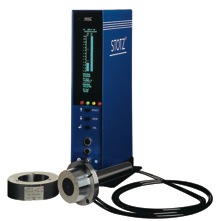 |
Air gauging relies on a law of physics that states flow and pressure are directly proportionate to clearance and react inversely to each other. As clearance increases, air flow also increases, and air pressure decreases proportionately. As clearance decreases, air flow also decreases, and air pressure increases.
This is accomplished by having a regulated air flow that travels through some type of restriction, such as a needle valve or jeweled orifice, and then through the nozzle in the air tool. As the obstruction (i.e., workpiece) is brought closer to the nozzle, air flow is reduced and the back pressure is increased. When the nozzle is completely obstructed, the flow is zero, and the back pressure is equal to the regulated air. Conversely, when the nozzle is open to the atmosphere, air flow is at a maximum, and the back pressure is at a minimum.
…
Add new comment